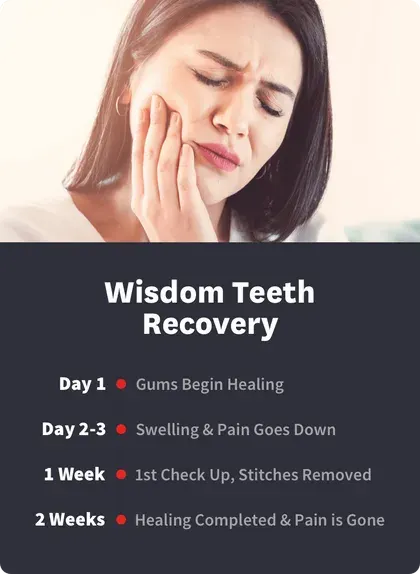Wisdom Teeth Recovery: Timelines, Healing Tips & Home Remedies.

Table of Contents
- Why Are They Removed?
- Removal Process
- Healing Timeline
- Healing Process Support
- Home Remedies
- When to Call Your Dentist
- References
After wisdom teeth removal, it takes about two weeks for your mouth to fully heal. During this time, you’ll need to follow your dentist’s aftercare instructions.
They will recommend that you avoid smoking, drinking alcohol, using a straw, or chewing hard foods during this period. Ultimately, you’ll need to treat your mouth with care as it heals.
Why are wisdom teeth removed?
On average, 10 million wisdom teeth are removed every year in the U.S. It is one of the most frequently performed dental procedures throughout much of the world.
Most people need to have their wisdom teeth, or third molars, removed due to crowding. There is not enough room in their jaw to fit those back teeth without causing damage to the other teeth. Some people do not need the procedure, but dentists often recommend it as a precaution when the teeth start to come in.
The third molars are a set of four adult teeth at the very back of the mouth, which come in between the ages of 17 and 25. This is why they are so often called wisdom teeth — because young adults, not children, grow these teeth.
It is believed that early hominids needed wisdom teeth because of the uncooked roots, leaves, and meat they often ate. Once our human ancestors began to cook, we no longer needed them.
Today, the structure of our jaws has changed so much that we often cannot accommodate these teeth. This is why wisdom teeth are removed in most people.
What is the wisdom teeth removal process like?
For many people, wisdom teeth cause pain as they come in, and that pain often indicates they are damaging surrounding teeth. Your dentist will tell you whether you need to have these teeth removed, so it is important to have regular dental exams throughout your life.
Most dentists recommend removing wisdom teeth earlier, when the roots are halfway to two-thirds formed. It is a more straightforward procedure if they are removed at this point. However, some people have them removed later in life, for a variety of reasons.
Ask your dentist whether you need to have your wisdom teeth removed if you experience:
Red or swollen gums.
Tender or bleeding gums.
Pain in your jaw.
Swelling that feels like it is in or around the jaw.
Pain in teeth adjacent to your wisdom teeth.
Trouble opening your mouth.
Getting your wisdom teeth removed is almost always an outpatient surgery, even if you go under general anesthesia. Your periodontist or general dentist can often perform the surgery, but some cases may require an oral surgeon.
The procedure should not take very long, depending on the complexity of the surgery. In cases where the teeth are impacted, the surgery can be more complicated.
Once the anesthesia wears off, you can go home to recover. You won’t be able to drive, so you’ll need a friend or family member to drive you home.
You may need stitches, though this is becoming less common. Many dentists use dissolvable stiches. In some cases, you may have traditional stitches, though this is rare.
Your dentist will likely recommend medications like ibuprofen and acetaminophen to reduce pain and swelling. You may also receive a prescription for a specific painkiller, to address more intense pain for a few days after the surgery. Swelling and pain will start to go away fairly quickly, although you may feel tender or sore for several more days after the more acute pain subsides.
Wisdom tooth removal is a common surgery, so the two-week healing process is well understood and you will want to follow your dentist's aftercare instructions to avoid any setbacks.
How long does healing take after wisdom teeth are removed?
Since most people get their wisdom teeth removed all at once and go under general anesthesia, the healing process can take longer than other tooth removal procedures. Typically, it takes your mouth two weeks to heal after the operation.
Here are the stages of healing after wisdom tooth removal:
Blood clots form, which help bone and gums heal.
Swelling in your mouth and cheeks will go down. The area will feel less warm, and your pain will begin to lessen.
You will likely see your dentist again, so they can examine how well your gums are healing and remove any stitches they put in.
Jaw stiffness and soreness should be gone. You may still have tender gums.
Gums should be healed over completely, and any remaining stiffness or soreness should be gone.
In rare cases, you may develop a condition called dry socket, which is a painful condition caused by the blood clot coming loose or dissolving. This exposes the root and bone under the area where the gum should heal. You may be able to see the bone within the empty socket, but intense pain is the primary symptom. Talk to your dentist if you experience this.
If you notice pain getting worse or not going away, report this to your dentist immediately. This can also indicate there is an infection, which needs antibiotics.
How can you support the healing process?

Your dentist will tell you how to take care of your mouth after the procedure, but you can also take some additional steps at home to encourage the healing process.
To support the healing process:
Avoid brushing your teeth next to the extraction site for the first day or two. Brush the rest of your teeth as you normally would.
Gently rinse your mouth with water or a saline rinse, but do not vigorously rinse your mouth out.
Avoid smoking and drinking alcohol.
Do not drink through a straw, as this could disrupt the blood clot.
Avoid hot drinks for at least one day after the procedure.
Avoid foods that require vigorous chewing for a few days.
Some bleeding in the first 24 to 48 hours after surgery is normal. You will need to frequently change your gauze until the bleeding slows down and eventually stops.
You will not be able to brush, rinse, or floss for the first day after the operation. After that point, you can return to a gentle version of your oral hygiene routine. When you begin brushing, use a light hand.
Limit eating, drinking, and talking for the first day or two after the procedure. Once the bleeding stops, eat soft, lukewarm food and drink enough water. Balanced nutrition and good hydration will help you feel better and heal well.
You can keep the wound clean with special antiseptic mouthwash. Your dentist may prescribe some, or you can find some in a drugstore. Ask your dentist which brand they recommend.
You can also rinse with a gentle saline solution. Mix salt into warm, not hot, water. This solution can also soothe painful gums.
Prop your head up at night. This can prevent blood from pooling in your head, reducing how much pain and swelling you feel when you wake up.
Home remedies to aid wisdom teeth recovery.
In addition to the aftercare instructions from your dentist, there are other home remedies you can try to help the healing process.
Apply ice packs to the area for no more than 15 minutes at a time to reduce swelling. Wrap the ice pack in a towel.
Place whole cloves over the area. Cloves can work as a topical pain reliever.
Use a cotton swab to apply a drop of clove oil to the surrounding area.
Apply lukewarm green or black tea bags to the area, as they can ease pain and reduce inflammation.
Many people remember eating a lot of ice cream or mashed potatoes while they recovered from wisdom tooth removal. You may need to eat only soft, mild foods for a few days after this procedure.
These are common food recommendations following wisdom teeth removal:
Soft noodles
Eggs
Soup
Gelatin
Mashed banana
Any hard or chewy foods could be detrimental to the healing process, so avoid apples, carrots, seeds or nuts, dried fruit, gum, sticky candy, chips, and pretzels. Avoid hot and spicy foods.
You can slowly start reintroducing some foods after the first week. Wait until your mouth is fully healed for very crunchy, spicy, and sticky food.
What to do if you do not see healing.
If you don’t see healing in the area after a couple days, call your dentist or oral surgeon promptly. Things should be improving within two to three days, and if they’re not, it can be a sign of infection.
Call your doctor immediately if you experience any of these:
Intense, throbbing pain
Worsening swelling
Pus
Fever
Excessive bleeding
It’s a good idea to see your doctor if anything feels off. They can examine the area, ensure it is healing as it should, and prescribe any needed treatments.
